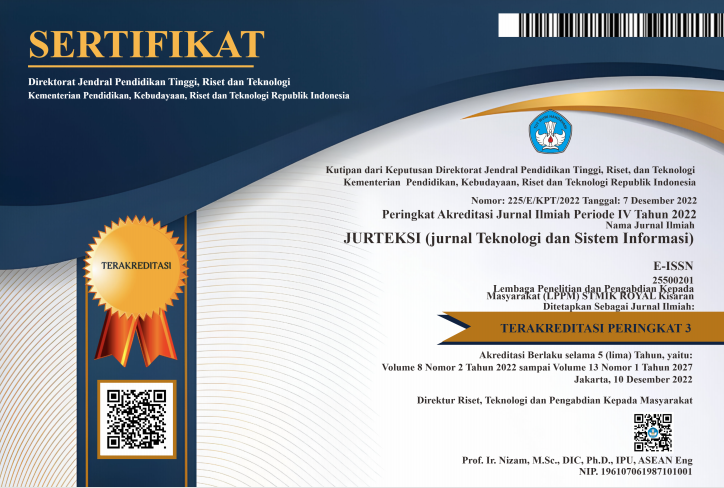CLASSIFICATION OF FAKE NEWS IN INDONESIAN LANGUAGE USING SUPPORT VECTOR MACHINE METHOD
Abstract
Abstract: Since information and communication technology has become ingrained in our daily lives, it has become easier to access information. However, there are some concerns. One of them is about fake news. The aim of this study is to develop an Indonesian system for detecting false news by utilizing news headlines. The methods used are linear kernel support vector ma- chine and n-gram. According to the findings of the performance test that was carried out, the linear kernel support vector machine model employing the term frequency inverse document frequency unigram feature performs better than utilizing bigram. The precision value generated from the model performance test is 1.00. This means that the degree of accuracy in matching the requested information regarding fake news detection with the answers provided by the system is very good. Then the recall value generated is 0.99. This means the linear kernel support vector machine model using unigram news features is very effective for detecting fake news according to the text classification approach.
Keywords: classification; fake news; n-gram; support vector machine
Abstrak: Dengan adanya integrasi teknologi informasi dan komunikasi dalam kehidupan mem- buat kemudahan dalam mengakses informasi. Walaupun demikian, terdapat kekhawatiran akan beberapa hal. Salah satu di antaranya adalah berita palsu. Tujuan penelitian ini adalah merancang sistem deteksi berita palsu berbahasa Indonesia berdasarkan judul berita. Metode yang digunakan adalah Support Vector Machine kernel linier dan n-gram. Berdasarkan hasil uji performa, model Support Vector Machine kernel linier yang menggunakan fitur term frequency inverse document frequency unigram menunjukkan kinerja yang lebih baik dibandingkan bi- gram. Nilai precision yang dihasilkan dari uji performa model sebesar 1,00. Ini berarti derajat akurasi dalam mencocokkan informasi yang diminta mengenai deteksi berita palsu dengan ja- waban yang diberikan oleh sistem sangat baik. Kemudian nilai recall yang dihasilkan sebesar 0,99. Ini berarti model Support Vector Machine kernel linier dengan menggunakan fitur berita unigram sangat efektif untuk mendeteksi berita palsu menurut pendekatan teks klasifikasi.
Kata kunci: klasifikasi; berita palsu; n-gram; support vector machine
References
M. P. Zagkotsis, Fake News Detec-tion using Deep Learning and Ma-chine Learning Methods - A com-parative study on short and long texts. Thessaloniki, 2019. [Online]. Available: https://ikee.lib.auth.gr/ record/305610
Asosiasi Penyelenggara Jasa Inter-net Indonesia (APJII), “Profil Inter-net Indonesia 2022,†2022. [Onl ine]. Available: https: //apjii.or.id /content/read/39/559/Laporan-Sur vei-Profil-Internet-Indonesia-2022
A. de Regt, M. Montecchi, and S. L. Ferguson, “A False Image of Health: How Fake News and Pseu-do-Facts Spread in the Health and Beauty Industry,†Journal of Prod-uct and Brand Management, p. 43, 2019, doi: https://doi.org/10.1108 /JPBM-12-2018-2180.
P. Nordberg, J. Kävrestad, and M. Nohlberg, “Automatic detection of Fake News,†in Proceedings of the 6th International Workshop on So-cio-Technical Perspective in IS De-velopment (STPIS 2020), Grenoble, France: CEUR-WS, Jun. 2020, pp. 168–179.
A. C. Milano, “Klasifikasi Penyakit Daun Padi Menggunakan Model Deep Learning EfficientNet-B6,†Jurnal Informatika dan Teknik El-ektro Terapan, vol. 12, no. 1, Art. no. 1, Jan. 2024, doi: 10.23960/jitet. v12i1.3855.
D. Jollyta, Prihandoko, A. Hajjah, E. Haerani, and M. Siddik, Algorit-ma Klasifikasi Untuk Pemula Solusi Python dan RapidMiner. Deepub-lish, 2023.
B. Probierz, P. Stefański, and J. Kozak, “Rapid detection of fake news based on machine learning methods,†Procedia Computer Sci-ence, vol. 192, pp. 2893–2902, Jan. 2021, doi: 10.1016/j.procs.2021. 09.060.
R. R. Sani, Y. A. Pratiwi, S. Winar-no, E. D. Udayanti, and F. Alzami, “Analisis Perbandingan Algoritma Naive Bayes Classifier dan Support Vector Machine untuk Klasifikasi Berita Hoax pada Berita Online In-donesia,†JURNAL MASYARA-KAT INFORMATIKA, vol. 13, no. 2, pp. 85–98, Nov. 2022, doi: 10.14710/ jmasif.13.2.47983.
T. Chauhan and H. Palivela, “Opti-mization and improvement of fake news detection using deep learning approaches for societal benefit,†In-ternational Journal of Information Management Data Insights, vol. 1, no. 2, p. 100051, Nov. 2021, doi: 10.1016/j.jjimei.2021.100051.
R. Wati, “Penerapan Algoritma Na-ive Bayes dan Particle Swarm Op-timization untuk Klasifikasi Berita Hoax pada Media Sosial,†JITK (Jurnal Ilmu Pengetahuan dan Teknologi Komputer), vol. 5, no. 2, Art. no. 2, Feb. 2020, doi: 10.33480/jitk.v5i2.1034.
N. Nurhayati and A. Pasaribu, “Perancangan Sistem Pendeteksi Berita Hoax Menggunakan Algo-ritma Levenshtein Distance Berbasis Php,†Jurnal SAINTIKOM (Jurnal Sains Manajemen Informatika dan Komputer), vol. 19, no. 2, Art. no. 2, Aug. 2020, doi: 10.53513/jis.v19i2.2601.
M. T. Septiyan, W. M. Rahmawati, and S. R. Wardhana, “Pengaruh Penggunaan Information Gain da-lam Peningkatan Akurasi Deteksi Berita Palsu,†Prosiding Seminar Nasional Teknik Elektro, Sistem In-formasi, dan Teknik Informatika (SNESTIK), vol. 1, no. 1, Art. no. 1, Jul. 2021, doi: 10.31284/p.snestik .2021.1463.
A. R. Jamaludin and E. B. Setiawan, “Deteksi Berita Hoax Di Media Sosial Twitter Dengan Ekspansi Fitur Menggunakan Glove,†eProceedings of Engineering, vol. 9, no. 3, Art. no. 3, Jun. 2022, Accessed: Nov. 08, 2023. [Online]. Available: https://openlibrarypublications.telkomuniversity.ac.id/index.php/engin eering/article/view/17986
E. Edward, “Identifikasi Berita Hoax Berbasis Web Menggunakan Algoritma C4.5,†Jurnal Ilmu Kom-puter dan Sistem Informasi, vol. 9, no. 1, Art. no. 1, 2021, doi: 10.24912/jiksi.v9i1.11558.
F. Ismayanti and E. B. Setiawan, “Deteksi Konten Hoax Berbahasa Indonesia Di Twitter Menggunakan Fitur Ekspansi Dengan Word2vec,†eProceedings of Engineering, vol. 8, no. 5, Art. no. 5, Oct. 2021, Ac-cessed: Nov. 08, 2023. [Online]. Available: https://openlibra rypubli-cat ons.telkomuniver sity.ac.id/ind ex.php/engineering/article/view/15697
F. N. Rozi and D. H. Sulistyawati, “Klasifikasi Berita Hoax Pilpres Menggunakan Metode Modified K-Nearest Neighbor dan Pembobotan Menggunakan TF-IDF | Konvergen-si,†KONVERGENSI, vol. 15, no. 1, pp. 1–10, Jan. 2019, doi: https://doi.org/10.30996/konv.v15i1.2828.













